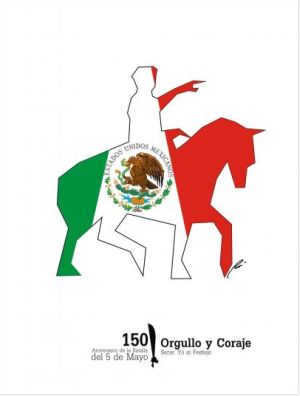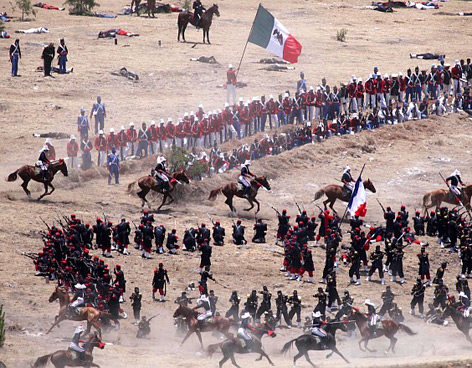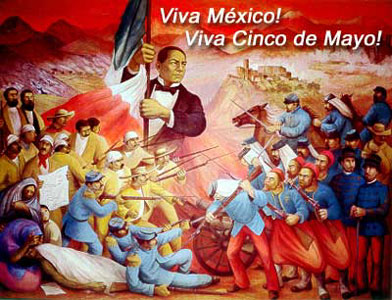 It’s curious to see how on the US side of the border, 5 de mayo is celebrated on such a grand scale, and yet for those of us who live in Mexico – well, except for those in the state of Puebla – it is simply another festive day (and a day off sometimes when it falls in the middle of the week). Nevertheless, this does not take away from its importance, though the grand national celebration in Mexico (Independence Day) is really September 16th.
It’s curious to see how on the US side of the border, 5 de mayo is celebrated on such a grand scale, and yet for those of us who live in Mexico – well, except for those in the state of Puebla – it is simply another festive day (and a day off sometimes when it falls in the middle of the week). Nevertheless, this does not take away from its importance, though the grand national celebration in Mexico (Independence Day) is really September 16th.
5 de mayo celebrates a very important event for Mexicans; it commemorates when the Mexican army defeated the French during a battle in Puebla de Zaragoza in 1862 – or rather, the Battle of Puebla. This year marks the 150th celebration of this momentous victory in Mexico’s history!
Looking back to its history, following excesses from under the “Santanista” dictatorship (of Antonio López de Santana) and battles in the war for reform, Mexico found itself broke and unable to cover its debts with other countries.
 In 1862, the armies of Spain, England, and France arrived at the Port of Veracruz quite ready to collect on their loans. After negotiating with Mexico’s representative, Spain and England both left, yet France had other intentions and took advantage of the country’s weakness. Napolean III, Emperor of the Second French Empire, wanted to establish a monarchy that would be favorable to France, and also wanted to dissolve the Constitutional Government of Mexico.
In 1862, the armies of Spain, England, and France arrived at the Port of Veracruz quite ready to collect on their loans. After negotiating with Mexico’s representative, Spain and England both left, yet France had other intentions and took advantage of the country’s weakness. Napolean III, Emperor of the Second French Empire, wanted to establish a monarchy that would be favorable to France, and also wanted to dissolve the Constitutional Government of Mexico.
The French forces, under the command of General Lorencez, were made up of 7,000 soldiers who departed from Veracruz marching toward Mexico City.
Mexican President Juárez ordered General Ignacio Zaragoza to detain the advancing French forces at the Loretto and Guadalupe Forts near the city of Puebla. Zaragoza only had 4,000 men.
On May 5th, 1862, the battle commenced, with cannon fire and rifles echoing through the air. Approximately 1,000 French soldiers were killed and the Mexican forces were victorious. They had won the battle, but not the war, as some time after France imposed the Second Mexican Empire.
By June of 1864, Maximiliano de Habsburgo and his wife, Carlota (who were Austrian), arrived in Mexico City in order to take possession of the recently formed (French) Mexican Empire and were thus crowned the Emperors of Mexico.
However, the history does not end there. Those known as republicans did not accept these new rulers and took refuge in the northern part of the country, asking for help from those in California and other Mexican-American societies with financing and volunteers for the ensuing battle. Following its own Civil War, the U.S. pressured France to leave, which they did in 1867 thereby returning Mexico to its autonomous state.
Despite the eventual success, this date – 5 de mayo – symbolizes the courage, strength and Mexican tenacity to fight for freedom when confronted with such a formidable army.
5 de mayo
Es curioso ver como del otro lado de la frontera el festejo del 5 de mayo es bastante grande y vistoso, y para los que vivimos en México, a excepción del estado de Puebla es solo un día de asueto tranquilo, ligeramente festivo (si cae entre semana, por supuesto) . Sin embargo no por eso carece de importancia, solo que la fiesta grande nacional de México es el 16 de septiembre.
El cinco de Mayo se celebra un acontecimiento muy importante para los mexicanos. Rememora cuando el Ejército de México pudo derrotar a los franceses, en la batalla que se llevó a cabo en Puebla de Zaragoza, en 1862.
 Después de los excesos de la dictadura “santanista” ( de Antonio López de Santana)y las batallas de la guerra de Reforma, México se encontraba en bancarrota y sin poder saldar sus deudas con los países acreedores. En 1862 las armadas de España, Inglaterra y Francia desembarcaron en el puerto de Veracruz dispuestas a cobrar sus préstamos. Después de negociar con el representante de México España e Inglaterra se retiraron. Pero Francia tenía otras intenciones y aprovechó la debilidad del país. Napoleón III, Emperador del Segundo Imperio Francés quería establecer una monarquía favorable para Francia, y asimismo, quería disolver el Gobierno Constitucional Mexicano.
Después de los excesos de la dictadura “santanista” ( de Antonio López de Santana)y las batallas de la guerra de Reforma, México se encontraba en bancarrota y sin poder saldar sus deudas con los países acreedores. En 1862 las armadas de España, Inglaterra y Francia desembarcaron en el puerto de Veracruz dispuestas a cobrar sus préstamos. Después de negociar con el representante de México España e Inglaterra se retiraron. Pero Francia tenía otras intenciones y aprovechó la debilidad del país. Napoleón III, Emperador del Segundo Imperio Francés quería establecer una monarquía favorable para Francia, y asimismo, quería disolver el Gobierno Constitucional Mexicano.
Las fuerzas francesas al mando del general Lorencez se componían de (7.000) siete mil soldados que salieron hacia la ciudad de México. El Presidente Juárez le dio la orden al General Ignacio Zaragoza de detener el avance de las fuerzas armadas francesas en los fuertes de Loreto y Guadalupe cerca de la ciudad de Puebla. Se cuenta que Zaragoza contaba con sólo (4,000) cuatro mil hombres.
El 5 de mayo de 1862, la batalla se desato, haciendo resonar cañones y rifles, donde aproximadamente (1,000) mil soldados franceses cayeron muertos. Saliendo los mexicanos victoriosos del encuentro. Habían ganado la batalla, pero no la guerra y Francia tiempo después impuso el Segundo Imperio Mexicano. Para junio de 1864, Maximiliano de Habsburgo y su esposa Carlota (austriacos) llegaron a la ciudad de México para tomar posesión del recién formado Imperio Mexicano y fueron coronados como el Emperador y la Emperatriz de México.
Pero la historia no termina ahí. Los republicanos no aceptaron a estos nuevos regentes y se refugiaron en el norte del país, pidiendo ayuda a californianos y otras sociedades mexicano americanas con financiamiento y voluntarios para la lucha. Estados Unidos al término de su guerra civi presionó a Francia para que se retiraran, marchándose estas en 1867, devolviéndole a México su autonomía.
A pesar del éxito posterior, esta fecha en especial es la que simboliza el valor, la fuerza y la tenacidad mexicana de luchar por su libertad ante una armada tan formidable.
